What's inside
If you ask the average gym-goer what a weight training program looks like, most would probably describe something resembling a bro split.
The bro split has been one of the most popular styles of resistance training since the golden age of bodybuilding in the ‘70s.
Other styles of weight training have gained popularity in recent years, but the classic bro split is still used by many bodybuilders and trainees.
This article digs a little deeper into the bro split workout, its benefits, drawbacks, and distinguishing features.
We also have a complete bro split workout program for you to try, either to switch from or to tweak your current routine.
What is a bro split?
A bro split is a workout program used in bodybuilding-style training to isolate the major muscle groups into their own sessions.
The split typically breaks the muscle groups into separate workouts for the chest, back, legs, shoulders, and arms.
While there are many ways a bro split can be modified for the individual, a typical bro split program is a five-day, Monday-to-Friday training routine.
It’s used widely in fitness culture since many top professional bodybuilders swear by it.
Is the bro split effective?

The bro split routine has several features that make it effective for muscle growth and development.
First, a bro split schedule allows for dedicated workouts for the muscle groups mentioned above.
This allows the athlete to program a greater number of different exercises to target specific areas of that muscle group.
For example, a typical bro split workout for the chest will include exercises for the upper, middle, and lower segments of the muscle.
It will also have different exercises allowing for heavy loads, stretch under tension, or other training variables that can stimulate muscle growth.
The Pros and Cons of a Bro Split Workout
Related: Reverse Pyramid Training
Bro Split Workout Benefits
As mentioned, the bro split routine allows for a greater variety of exercises to be programmed for each muscle group.
Also, a 5-day bro split allows ample recovery time between sessions aimed at a certain muscle.
The overall level of fatigue is lower with a bro split as well. Targeting one smaller muscle group at a time is less taxing on the central nervous system.
Bro Split Workout Disadvantages
Bro split workouts do have some drawbacks, however. The first of these is the delayed onset muscle soreness, or DOMS.
If you don’t like being super sore for several days after your workout, the bro split may not be for you.
With the sole aim to destroy a muscle so much it is forced to grow, you are going to be sore somewhere almost all the time.
Even the best bro split program will also only hit each muscle group once per week, which can limit gains in some cases – especially if you don’t make your one session count.
The bro split workout routine may also not be the best choice for time-poor people. You’ll need to hit the gym five to six days per week.
See the later section for comparisons of the bro split routine with other popular workout splits.
Popular Styles of Training Methods for Bro Splits
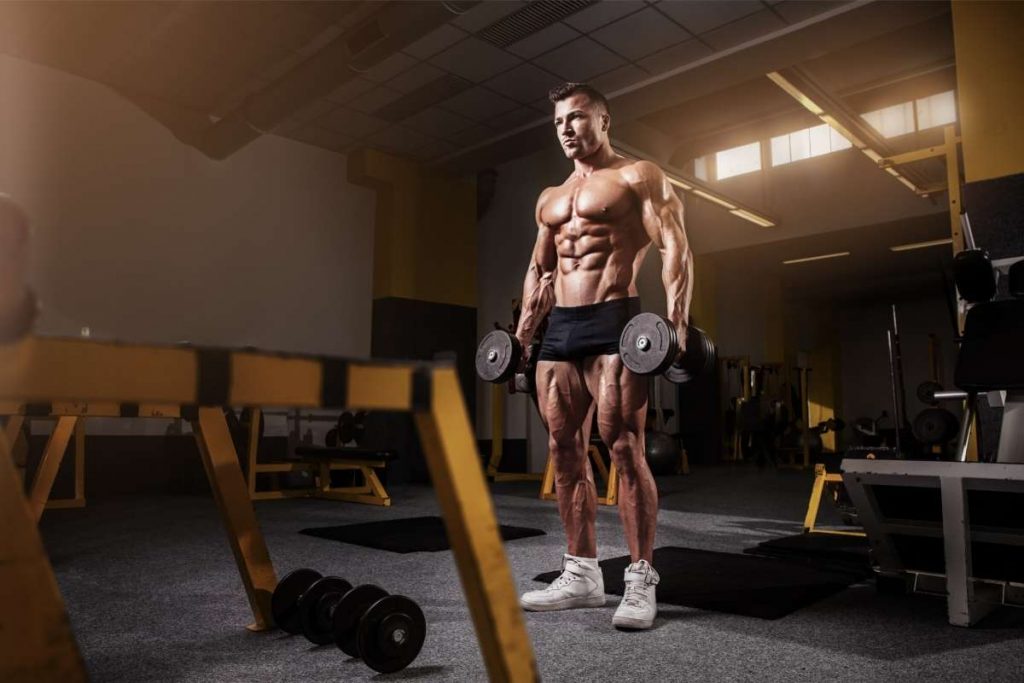
Because bro split workouts are often used by experienced or advanced lifters, they often utilize advanced training techniques to stimulate muscle growth.
The following are just some of the methods used in a bro split workout plan to push the muscles past failure.
Progressive Overload
This first one is more of a general training principle used for the overall program than in a given workout set.
Progressive overload means that you need to be performing at a consistently higher level from week to week, and session to session wherever possible.
This may mean increasing the weight, pushing for an extra rep, or using some of the techniques below to give your muscles a reason to respond.
Reverse Pyramid
The reverse pyramid is a method that makes the most of your strength levels while you’re fresh.
These sets involve lifting at a higher weight for lower reps in the first set, followed by several sets of slightly decreased weight with more repetitions.
For example, a reverse pyramid with a dumbbell overhead press could be 4-6 reps x 45lbs (20kg), 5-8 reps x 40lbs (17.5kg), and 6-10 reps x 35lbs (15kg).
Keep in mind that this doesn’t mean you don’t perform warm-up sets before lifting heavy.
Drop Sets
Drop sets are like a reverse pyramid within one exercise set.
They involve working until failure on a given exercise, dropping to the next weight down, and continuing until failure again.
Multiple drops can be done in one set, for example. Cable curls for 13 reps x 65lbs (30kg), straight into another 8 reps x 55lbs (25kg), and finally another 7 reps x 45lbs (20kg).
Drop sets are best saved for the final set or two of an exercise to keep fatigue from shortening the session.
Supersets
Another technique is supersets, which involves performing two exercises back-to-back without rest.
Supersets can entail two exercises for the same muscle group or two different muscle groups.
This can either overload the muscle or let you rest one muscle while still working another.
Some examples include a set of bench presses followed immediately by push-ups to failure or supersetting bicep curls with tricep extensions in an arms session.
Negative Reps
Negative reps are the eccentric portion of a lift, meaning you’re lowering the weight against gravity or elongating the muscle under load.
Eccentric strength in the muscles is significantly higher than the concentric portion, meaning you can often perform more negative reps even after failure.
You can take advantage of negative reps either by assisting the concentric portion to perform more reps or by using a slow negative phase.
For example, you could perform a set of pull-ups to failure, then jump up and control yourself down slowly for several more negative reps.
Partial Reps
The final example of advanced bro split techniques we have for you is partial reps, which are just what they sound like.
Partial reps can be used beginning, during, or at the end of a set with different effects.
For example, the 1 ½ technique involves performing a full range rep followed by a partial range.
Another example is performing full-range reps until failure before continuing with partial range for several more to push beyond failure.
With some of the most commonly used advanced bro split workout techniques covered, let’s take a look at some of the best exercises to include in your bro split routine.
10 of the Best Bro Split Workout Exercises
Related: Horizontal Push Exercises
1. Incline Bench Press
The first chest exercise on this list focuses on the upper portion of the muscle, the clavicular head.
Changing the emphasis to this section of the muscle fibers ties the chest muscles to the shoulders and creates that ‘shelf’ look.
The angle of the bench allows a greater stretch and a more comfortable range of motion for some trainees.
How-To Perform Incline Bench Press:
- Lay on the incline bench with the eyes under the bar
- Reach straight up and grab the bar, unrack the weight
- Control the bar down to the upper chest
- Squeeze the shoulder blades together before pressing up
- Contract the chest as you press the bar to the top position
- Repeat for target repetitions
Benefits: Adds mass and definition to the upper chest for a more aesthetic side chest angle
Pro Tips: Pause briefly at the bottom of the movement to emphasize the stretch under tension.
2. Decline Cable Crossover
After hitting the upper chest with the incline press, you’ll want an exercise that will recruit the lower, or abdominal fibers.
This exercise is one of the best for activating the pec muscles, with less involvement from the shoulders and triceps.
This isolates the chest and the cables give you the freedom to get as much stretch, or full contraction, as you like.
How-To Perform Decline Cable Crossover:
- Set the cables at higher than shoulder level
- Grab both handles and bring the hands together in front of the hips
- Stand with one foot forward, leaning slightly forward at the hips
- Bring the arms out in an arc up to shoulder level
- Brace the abs and squeeze back down to bring the hands together
- Repeat for desired repetitions
Benefits: Isolates the pectoral muscles with a focus on the sternal and abdominal fibers
Pro Tips: Turn the pinky fingers in toward each other at the bottom of the movement for an extra chest squeeze.
3. Incline Supported Row
To create a balanced physique, we next want to include some muscle-building moves for the back.
The incline-supported row has the advantage of taking pressure off the spine, while also targeting the larger upper back muscle groups.
This exercise can be done with dumbbells or barbells depending on what you have on hand.
How-To Perform Incline Supported Row:
- Lay face-down on the incline bench and take up the weight in each hand
- Press the feet into the ground and squeeze the glutes
- Breathe out and pull the weight up to the lower chest
- Keep the elbows close to the body as you slowly lower down until arms are straight
- Repeat for prescribed repetitions
Benefits: Safe and effective mass-builder for the upper back, also helps posture
Pro Tips: Squeeze the shoulder blades back and down at the top of the movement with a brief pause for a great posture-building position.
4. High Cable Archer Row
After hitting the mid and upper traps, this next exercise adds a rotational element to your back training.
Not only is the archer row great for developing the lats, but it also builds a lot of core strength and rotational resistance.
This exercise will help build a wide, V-tapered look for a classic bodybuilding physique.
How-To Perform High Cable Archer Row:
- Stand side-on to the high cable handle
- Reach across the body to grab the handle
- Stay centered and exhale to pull the handle to the same-side shoulder
- Squeeze the elbow back and down while rotating the body to the front
- Slowly control the weight back to the start position
- Repeat on both sides for repetitions
Benefits: Builds single-side scapular control and core strength against rotational forces
Pro Tips: Keep the handle close to the body and lead the movement with the elbow.
5. Leg Extension
Related: 10 Best Outer Quad Exercises
While squat variations are definitely included in the programs below, one of the best accessory exercises for the quads is the leg extension.
Available in most gyms, this exercise allows you to target the various heads of the quadriceps muscles in their primary movement of knee extension.
For those who find that their glutes and hamstrings tend to dominate squats, this is a must-include to build large, defined quad muscles.
How-To Perform Leg Extension:
- Sit in the machine with the appropriate settings for the seat and foot pads
- Hold the handles at either side of the body
- Sit tall and brace the core
- Breathe out and squeeze the quads to lift the pad to full extension
- Hold at the top briefly before slowly lowering to the start position
- Repeat for necessary reps
Benefits: Arguably the best quadriceps isolation exercise to sculpt the different portions of the quads
Pro Tips: Turn the toes inward, outward, or straight up to target the lateral, medial, or overall muscular heads.
6. Bulgarian Split Squat
Another challenge some people have with a traditional barbell squat is the ability to go to a sufficient depth with good form.
The split squat allows a much deeper range of motion in the squat movement while also avoiding having the weight on the back.
Another bonus is that you can isolate each leg to ensure even muscle development.
How-To Perform Bulgarian Split Squat:
- Set up standing in front of a bench, holding dumbbells in each hand
- Place one foot behind you on the bench
- Drop the back knee toward the floor while sitting the hips back
- Squat down until the front thigh is at least parallel to the floor
- Maintain an upright torso while pushing through the heel to the starting position
- Repeat designated repetitions on both legs
Benefits: Adjustable single-leg mass builder that can be safer for less experienced lifters
Pro Tips: Avoid letting the front heel raise off the ground while pressing to protect the knee from strain.
7. Machine Lateral Raise
Moving to one of the most important muscle groups for an aesthetic physique, the machine lateral raise will help build the sought-after ‘boulder shoulder’ look.
Isolating the medial deltoid in shoulder abduction, the machine version of this exercise provides consistent tension throughout the range of motion.
It also makes it easier to avoid using momentum and bringing the trapezius muscles in to do the work instead of the target muscle.
How-To Perform Machine Lateral Raise:
- Sit facing the pad with the arms by the sides holding the handles
- Sit tall and push the shoulders down and back slightly
- Focus on the outer shoulders as you raise the elbows out and up
- Hold the tension at the top briefly, before slowly controlling to the starting position
- Repeat until target repetitions are reached
Benefits: Consistent difficulty rather than high strength curve like the dumbbell version
Pro Tips: Avoid shrugging the shoulders up. Think about pushing the elbows outward while keeping a long neck.
8. Dumbbell Reverse Flys
Related: How to Reduce Broad Shoulders For Female
After focusing on the middle shoulder head, it’s time to build the most neglected part of the deltoid muscle.
Reverse flys are an important exercise for building the size and definition of the shoulders, especially when viewed from a side pose.
Building strong rear delts will also help bulletproof the shoulders against injury in the long term.
How-To Perform Dumbbell Reverse Flys:
- Sit on the end of a bench with a dumbbell in each hand
- Hinge forward from the hips, keeping a neutral spine
- Bring the weights together underneath the legs, palms facing each other
- Brace the core before exhaling to raise the weights out to the sides
- Hold at the top and squeeze the back of the shoulders
- Control slowly to the starting position, keeping tension
Benefits: Completes shoulder development while also helping in shoulder joint health
Pro Tips: Focus on building a mind-muscle connection with the rear deltoid muscle, as many upper back muscles will want to take over on this exercise.
9. Cable Bicep Curl
Finally, we move on to many people’s favorite muscle group, the arms.
First, we will pump plenty of blood through the biceps with a cable variation of a curl.
The cable is a great option for newer lifters too, as it’s easier to push to failure with decent form.
How-To Perform Cable Bicep Curl:
- Stand in front of pulley with the handle at a low setting
- Keep the elbows tight to the sides
- Pull the handle up toward the shoulders
- Squeeze the biceps and lower slowly
- Repeat until failure or recommended reps are complete
- Squat down safely to return handle to floor
Benefits: Consistent strength curve, simple to maintain good form while pushing hard
Pro Tips: Vary your grip width or even the handle style to focus on different elbow flexor muscles and bicep heads.
10. French Press
After warming the arms up, it’s time for something to build the larger triceps muscles of the upper arm.
The French press provides good tension in a stretched position, giving extra attention to the long head of the triceps.
This exercise also helps open up the shoulders and maintain good posture and mobility.
How-To Perform French Press:
- Sit on a bench and lift the weights overhead
- Keep the hands close and the elbows above the shoulders
- Lower the weight behind the head, until a good stretch is felt in the triceps
- Squeeze the triceps to extend the elbow, lifting the weight back overhead
- Repeat as required and safely lower weights to floor
Benefits: Develops large tricep muscle, stretch position good for muscle growth and flexibility
Pro Tips: Keep the tension on the triceps by squeezing up and slightly behind the head, rather than straight above.
The Best 5-Day Bro Split Workout Plan with PDF
Related: Muscle Gain Workout Plan With PDF
The effective exercises above are all included in the following bro split workout plan, along with many other great movements.
This is a 5-day bro split program with workouts for the chest, back, legs, shoulders, and arms.
The bro split schedule spans from Monday to Friday, although you could also include a rest day during the week and train the fifth session on Saturday if you prefer.
You’ll notice that each session has suggestions for how to utilize some of the advanced training techniques mentioned above.
This is optional for those who need the extra boost to their gains. However, the workouts can also be done without these techniques added.
Familiarize yourself with the workouts, give them a try (with or without the advanced techniques) for a couple of weeks, and see the section below for how to progress.
Monday: Chest
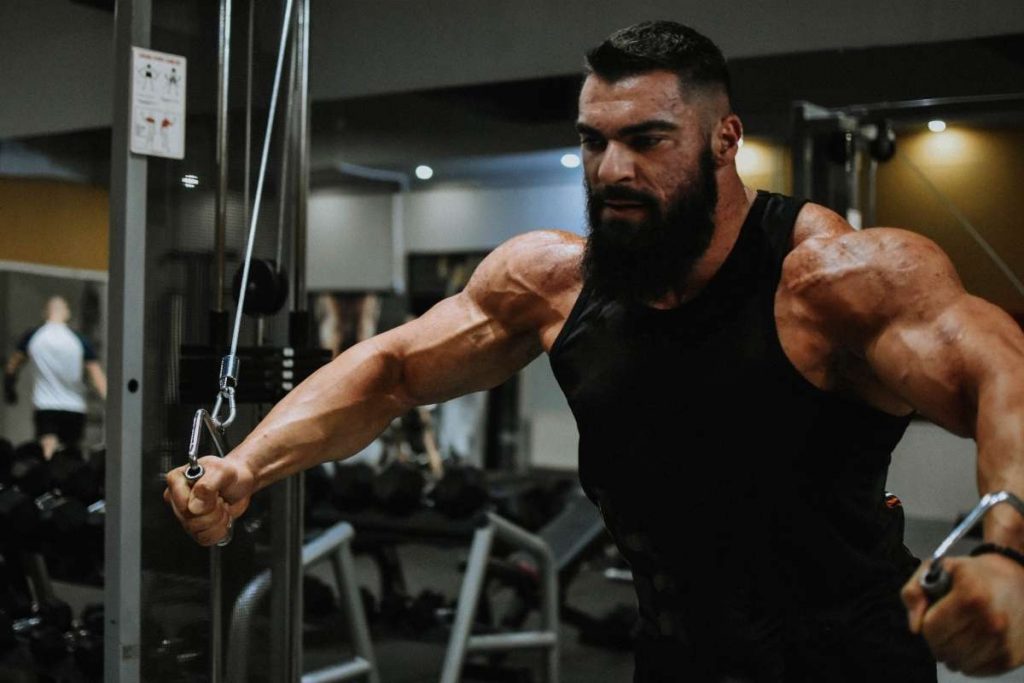
Warm-up: General warm-up 5 mins, arm circles x 10 each direction, torso twists x 20, wrist circles x 10 each direction, push-ups x 10-20, 1-2 warm-up sets first exercise
| Exercise | Sets x Reps | Advanced Technique | Rest |
| Incline bench press | 3-4×6-8 | – | 2-3 mins |
| dB bench press | 3-4×10-12 | Superset w push-ups to failure | 2-3 mins |
| Chest fly machine | 3-4×6-8 | Drop set x3 on final set | 1-2 mins |
| Decline cable crossover | 3-4×8-10 | 1 1/2 inner partial reps | 1-2 mins |
| Single-arm incline cable crossover | 3-4×10-12 each side | Extra negative reps on final set | – |
Estimated Workout Duration: 60 mins including warm-up
Tuesday: Back
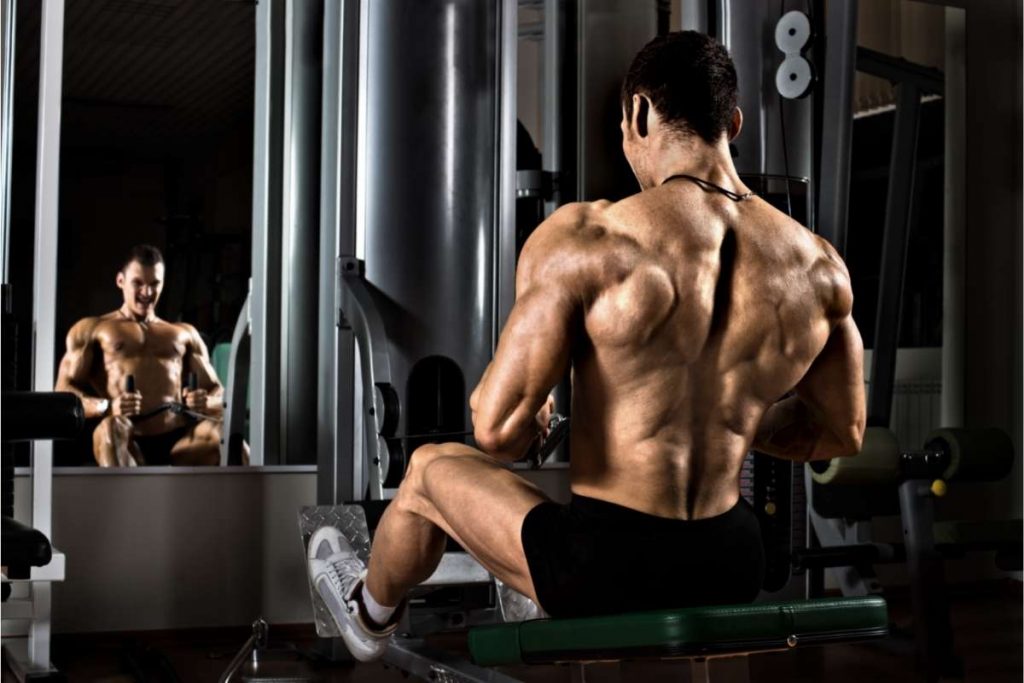
Warm-up: General warm-up 5 mins, arm circles x 10 each direction, torso twists x 20, wrist circles x 10 each direction, inverted row x 10-20, 1-2 warm-up sets first exercise.
| Exercise | Sets x Reps | Advanced Technique | Rest |
| Incline supported row | 3-4×6-8 | – | 2-3 mins |
| Wide pull-up / pulldown | 3-4×10-12 | Superset w inverted rows to failure | 2-3 mins |
| High cable archer row | 3-4×8-10 | – | – |
| Kneeling cable straight-arm pushdown | 3-4×10-12 | Extra negative reps on final set | 1-2 mins |
| Back extension | 3-4×10-12 | Superset w decline crunch | 1-2 mins |
Estimated Workout Duration: 60 mins including warm-up
Wednesday: Legs
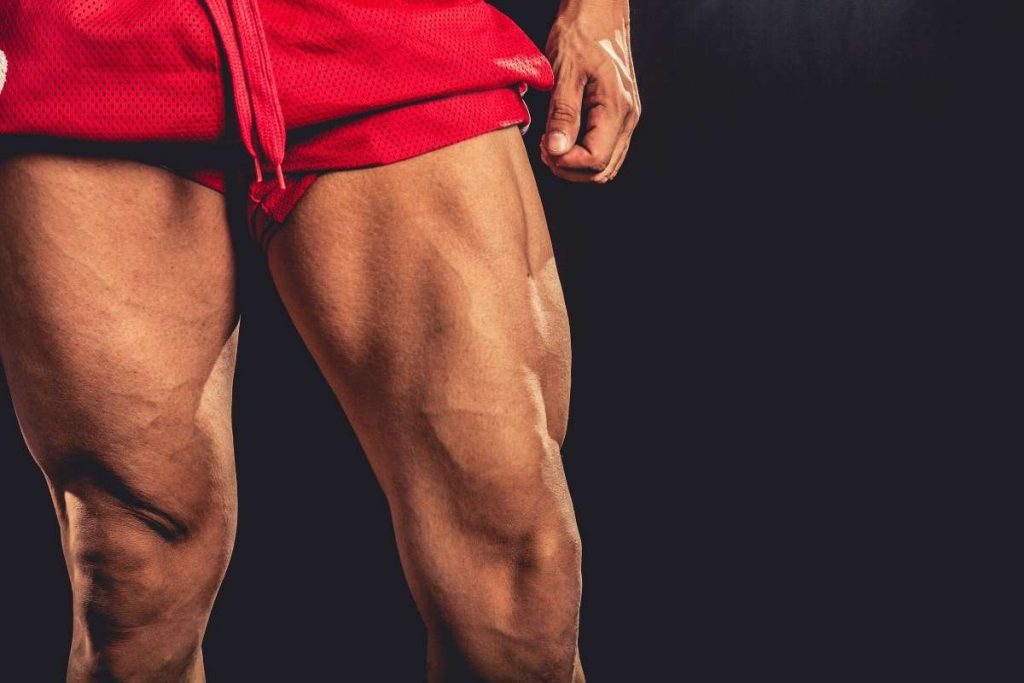
Warm-up: General warm-up 5 mins, leg swings x 10 each direction, torso twists x 20, ankle circles x 10 each direction, air squats x 10-20, 1-2 warm-up sets first exercise.
| Exercise | Sets x Reps | Advanced Technique | Rest |
| Hack squat machine | 3-4×6-8 | 5 second negatives | 2-3 mins |
| Leg extension | 3-4×10-12 | Superset w hamstring curl | – |
| Hamstring curl | 3-4×10-12 | “ | 1-2 mins |
| Bulgarian split squat | 3-4×10-12 each leg | Drop set x3 on final set | – |
| Standing / seated calf raise | 3-4×8-20 | Reverse pyramid sets | 30-60 sec |
Estimated Workout Duration: 60 mins including warm-up
Thursday: Shoulders
Warm-up: General warm-up 5 mins, arm circles x 10 each direction, torso twists x 20, wrist circles x 10 each direction, push-ups x 10-20, 1-2 warm-up sets first exercise.
| Exercise | Sets x Reps | Advanced Technique | Rest |
| Arnold press | 3-4×6-12 | Reverse pyramid sets | 2-3 mins |
| Barbell shrugs | 3-4×6-8 | Drop set x3 on final set | 2-3 mins |
| Machine lateral raise | 3-4×10-12 | Drop set x3 on final set | 1-2 mins |
| dB reverse flys | 3-4×10-12 | 5 second negatives | 1-2 mins |
| Face pulls | 3-4×10-12 | – | 1-2 mins |
| Cable rope ab crunch | 3-4×12-15 | Superset w hanging leg raise | 30-60 sec |
Estimated Workout Duration: 60 mins including warm-up
Friday: Arms

Warm-up: General warm-up 5 mins, arm circles x 10 each direction, torso twists x 20, wrist circles x 10 each direction, 1-2 warm-up sets first exercise.
| Exercise | Sets x Reps | Advanced Technique | Rest |
| Cable curls | 3-4×12-15 | Superset w cable tricep extension | – |
| Cable tricep extension | 3-4×12-15 | “ | – |
| Close grip EZ bar curl | 3-4×8-10 | Superset w lying tricep extension | – |
| EZ bar lying tricep extension | 3-4×8-10 | “ | 1-2 mins |
| dB incline curl | 3-4×10-12 | Superset w french press | – |
| dB French press | 3-4×10-12 | “ | 1-2 mins |
Estimated Workout Duration: 60 mins including warm-up
Saturday: Rest / Cardio
Sunday: Rest
The Best 5-Day Bro Split Workout Plan with PDF
How to Effectively Program a Bro Split Workout Plan
The bro split workouts above are programmed according to many of the fundamentals of resistance training.
The volume, rest periods, and exercise order are all done in service of what will produce the best results for muscle growth.
Over time, use the progressive overload principle to keep moving forward.
You can see in the tables that there are recommendations for the number of sets and reps for each exercise.
Start with the lower numbers. Each session, try to increase the repetitions to the higher number.
Once you reach this for all sets you can either add weight, add the additional set, or employ the advanced technique to progress.
You don’t have to progress every exercise every session, just be sure that you are slowly moving in the right direction.
With optimal nutrition, recovery, and consistency, this plan will help you add size and definition to your physique.
Bro Split vs. Other Workout Routines
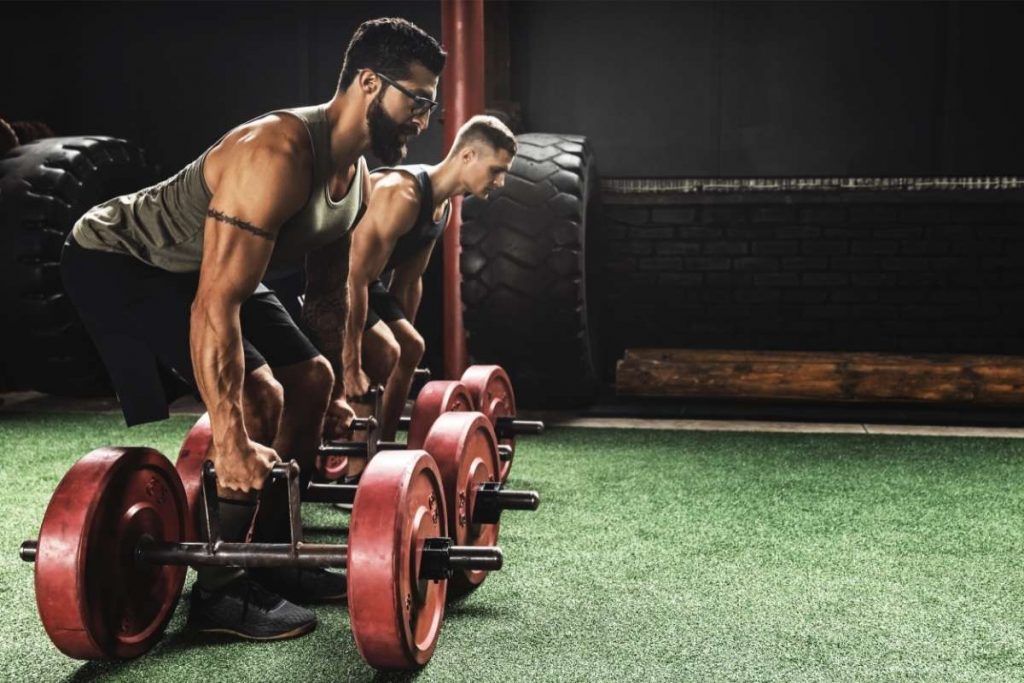
Push-Pull Legs vs. Bro Split
PPL is another of the most widely-used workout splits for experienced lifters.
The main difference between bro splits and PPL is the frequency per muscle group.
While both a bro split and PPL can have an overall frequency of six days per week, the PPL has two sessions for push, pull, and legs, while the bro split only has one for each muscle group.
Upper-Lower vs. Bro Split
Upper-lower splits allow even more frequency, allowing you three sessions for upper body and three for legs.
The advantage of the upper-lower split is that you get a lot more lower body volume, for those who want to focus on their chicken legs.
The drawback is that you have to combine the chest, back, shoulders, and arms into one session, which either limits the exercises or creates a four-hour workout session.
Full Body vs. Bro Split
The full-body workout plan is used by beginners and for general fitness. These sessions allow one to train the major muscle groups for strength and overall health.
The bro split is more for those who want to focus on specific muscles and sections of muscles, whether for bodybuilding competition or just personal preference.
These programs are less comparable in terms of effectiveness, as they are both good for different ability levels and goals.
Frequently asked questions
What is a bro split workout?
A bro split is a workout program that splits the major muscle groups into separate training days, usually over five or six sessions.
A typical bro split workout will contain a dedicated day to train the chest, back, shoulders, arms, and legs.
Why do a bro split?
Bro splits are great for being able to perform a wide variety of exercises to target different sections of a muscle group.
They’re also a lot of fun to train and allow you to get a good muscle pump in that day’s muscle group.
A bro split workout is also less fatiguing overall, as each session just focuses on a relatively small area.
Can you build muscle with a bro split?
The majority of professional bodybuilders use a bro split workout routine, and building muscle is their primary goal.
You can definitely add muscle mass with a bro split, and also shape and define each muscle more effectively when competing.
What’s the best bro split?
While there is no one ‘best’ bro split for everyone, the bro split can be used by many people with enough experience.
A good bro split will cover all the major muscle groups, and provide a way to progress over time to ensure continued success.
The bro split routine in this article is a good place to start, and you can make changes along the way as you progress.
Final Thoughts
So, what do you think of our bro split workout plan? If you can get to the gym most days of the week, it’s one of the most popular ways to train.
It also really lets you focus on one area at a time, which can help you appreciate your progress more.
Are you a bro split aficionado, or do you prefer a different split like PPL or upper body lower body?
Let us know your workout split – and your experience if you try our bro split program – in the comments.
If you have any training buddies looking to start with a bro split workout, share this article with them to get them going.

